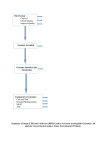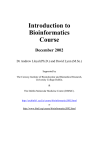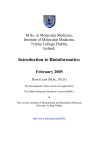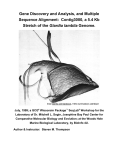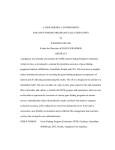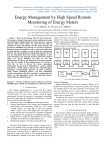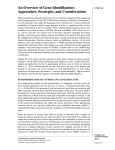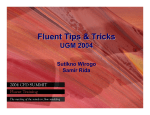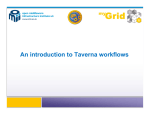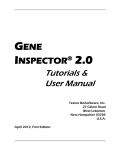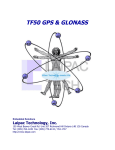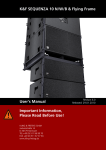Download Gene Finding Strategies - Department of Biological Science
Transcript
BSC4933/5936(5) Intro’ to BioInfo’ Lab #6 BSC4933/5936: Introduction to Bioinformatics Laboratory Section: Tuesdays from 3:45 to 5:45 PM. Gene Finding Strategies Week Six, Tuesday, September 30, 2003 Author and Instructor: Steven M. Thompson How are coding sequences recognized in genomic DNA? After the sequencing’s done, and the fragments have all been assembled, and preliminary database searches have been run, what’s next? What more can we learn about a nucleotide sequence? Searching by signal versus searching by content, i.e. transcriptional and translational regulatory sites and exon/intron splice sites, versus 'nonrandomness,' codon usage; and homology inference. Understanding the concepts and limitations of the methods and differentiating between the approaches. Steve Thompson BioInfo 4U 2538 Winnwood Circle Valdosta, GA, USA 31601-7953 [email protected] 229-249-9751 ¥ ® GCG is the Genetics Computer Group, part of Accelrys Inc., a subsidiary of Pharmacopeia Inc., ® producer of the Wisconsin Package for sequence analysis. ” 2003 BioInfo 4U 2 Nucleic Acid Characterization: Recognizing Coding Sequences Standard disclaimer I write these tutorials from a ‘lowest-common-denominator’ biologist’s perspective. That is, I only assume that you have fundamental molecular biology knowledge, but are relatively inexperienced regarding computers. As a consequence of this they are written quite explicitly. Therefore, if you do exactly what is written, it will work. However, this requires two things: 1) you must read very carefully and not skim over vital steps, and 2) you mustn’t take offense if you already know what I’m discussing. I’m not insulting your intelligence. This also makes the tutorials longer than otherwise necessary. Sorry. I use three writing conventions in the tutorials, besides my casual style. I use bold type for those commands and keystrokes that you are to type in at your keyboard or for buttons or menus that you are to click in a GUI. I also use bold type for section headings. Screen traces are shown in a ‘typewriter’ style Courier font and “////////////” indicates abridged data. The arrow symbol (>) indicates the system prompt and should not be typed as a part of commands. Really important statements may be underlined. As you’ve learned, specialized X-server graphics communications software is required to use GCG’s SeqLab. I’ll remind you of a few user hints while using X: X Windows are only active when the mouse cursor is in that window, and always close X Windows when you are through with them to conserve system memory. Furthermore, to activate X items, just <click> on them, rather than holding your mouse button down. Also, X buttons are turned on when they are pushed in and shaded. Finally, don’t close X Windows with the X-server software’s close icon in the upper right- or left-hand window corner, rather, always, if available, use the window’s own “File” menu “Exit” choice, or “Close,” or “Cancel,” or “OK” button. Introduction What sort of information can be determined from a genomic sequence? Easy restriction digests and associated mapping; e.g. software like the Wisconsin Package’s Map, MapSort, and MapPlot. Harder fragment assembly (e.g. Week Four’s GCG FAS) and genome mapping; like packages from the University of Washington’s Genome Center (http://www.genome.washington.edu/), Phred/Phrap/Consed (http://www.phrap.org/) and SegMap, and The Institute for Genomic Research’s (http://www.tigr.org/) Lucy and Assembler programs. Very hard gene finding and sequence annotation. This will be the topic of today’s tutorial and is a primary focus of current genomics research. Easy forward translation to peptides. Hard again genome scale comparisons and analyses. 3 How are encoded proteins recognized in uncharacterized eukaryotic, genomic DNA? Translating from all translational start codons to all ‘nonsense’ chain terminating, stop codons in every frame produces a list of ORFs (Open Reading Frames), but which of them, if any, actually code for proteins? And this only works in organisms without exons and introns. Three general solutions to the gene finding problem can be imagined: 1) all genes have certain regulatory signals positioned in or about them, 2) all genes by definition contain specific code patterns, and 3) many genes have already been sequenced and recognized in other organisms so we can infer function and location by homology if our new sequence is similar enough to an existing sequence. All of these principles can be used to help locate the position of genes in DNA and are often known as “searching by signal,” “searching by content,” and “homology inference” respectively. Homology inference can be very helpful, but what happens in the case where no similar proteins can be found in the databases, and even if homologues can be found, discovering exon-intron borders and UTRs (5’ and 3’ untranslated regions) can be very difficult. If you have cDNA available, then you can try to align it to the genomic in order to ascertain where the genes lay, but even this can be quite difficult and cDNA libraries are not always available. No one method is absolutely reliable, but one seldom has the luxury of knowing the complete amino acid sequence to the protein of interest and simply translating DNA until the correct pieces fall out. This is the only method that would be 100% positive. Since we are usually forced to discover just where these pieces are, especially with genomic DNA, computerized analysis becomes invaluable. DNA needs to be very special in order to encode genes. It must have regulational “switches” to turn things on and off, and most eukaryotic DNA must have “signals” that indicate the beginnings and ends of exons and introns. Coding regions must have certain periodicities and patterns. These constraints arise in a number of ways — the three base genetic code, the ‘wobble’ hypothesis, an unequal use of synonymous codons, translational factors, the amino acid content of the encoded proteins themselves, and, possibly, because of remnants of an ancient genetic code. The problem all comes down to figuring out all of your DNA’s URFs and ORFs — what’s the difference? Do any of them actually code for a protein? URF Unidentified Reading Frame — any potential string of amino acids encoded by a stretch of DNA. Any given stretch of DNA has potential URFs on any combination of six potential reading frames, three forward and three backward. ORF Open Reading Frame — by definition any continuous reading frame that starts with a start codon and stops with a stop codon. Not usually relevant to discussions of genomic eukaryotic DNA, but very relevant when dealing with mRNA/cDNA or prokaryotic DNA. The first order of business is to translate all six reading frames of the sequence because there is no way of knowing where any genes may lay upon it. DNA often has genes on opposite reading frames. This will generate all URFs as opposed to ORFs. This is an especially important distinction when dealing with 4 organisms that have exons and introns, since many exons will not begin with a start codon (only the first will necessarily begin with one); therefore, URFs are the more appropriate choice for most genomic eukaryotic sequences. After that’s done we can see that there are many potentially translated stretches, so what? What can be done with them; how can we turn them into potential genes? Signal searching: Signal searches look for transcriptional and translational features. Typical signals to look for are promoter and terminator consensus sequences and repeat regions. GCG provides a searching program named Terminator for looking for terminator sites in prokaryotic rhoindependent cases; however, promoter signals from both prokaryotes and eukaryotes are so varied that they do not have a ‘canned’ search for them. An impressive eukaryotic transcription factor consensus sequence database has been assembled though, and prokaryotic promoter sequences are fairly well characterized. We can utilize the Wisconsin Package program FindPatterns to look for these type of sites within our sequence. GCG also provides the ability to find short consensus patterns based on a family of related sequences using weight matrix analysis with the programs Consensus and FitConsensus. These can be used to form and search for specific promoters or other signals based on known sequences. Also, many termination sites are accompanied by inverted repeats, and enhancer sequences are often strong direct repeats; because of these points, the GCG programs StemLoop and Repeat, as well as dotplot procedures, may be helpful. Start sites Transcriptional regulatory sites such as promoters and other transcription factor and enhancer binding sequences can help identify the beginnings of genes; however, some of these motifs can be quite distant from the actual start of transcription. The prokaryote Shine-Dalgarno consensus, (AGG,GAG,GGA)x{6,9}ATG (Stormo et al., 1982), based on complementarity to 16s rRNA, obviously relates to translation initiation, as does the methionine start codon itself. Eukaryote ribosomes seem to initiate translation at the first AUG encountered following the modified guanosine 5’ cap and do not appear to be based on 18s complementarity. Kozak (1984) has compiled a Eukaryote start consensus of cc(A,g)ccAUGg that seems to hold true in many situations. However, matters can be complicated by alternative start codons; AUG works in about 90% of cases, but there are exceptions in some prokaryotes and organellar genomes. Exon-Intron junctions Well-characterized splice site donor-acceptor consensus sequences can point to intron-exon borders. The exon-intron junction has the following consensus structure around its donor and acceptor sites: Donor Site Acceptor Site Exonبææææææææææææ Intron æææææææææææÆØExon A64G73G 100T 100A62A68G84T63 . . . 6Py74-87NC65A 100G 100N 5 The splice cut sites occur before a 100% GT consensus at the donor site and after a 100% AG consensus at the acceptor site. GCG’s weight matrices for these sites do not start at the cut site, rather they start a varying distance upstream of it! End sites Transcriptional terminator and attenuator sequences can help identify gene ends, as do the chain termination ‘nonsense’ (stop) codons. The GCG program Terminator will find about 95% of all prokaryotic factorindependent terminators. This is great odds for any computer algorithm; even its namesake Arnold Schwarzenegger would have a hard time matching this! But that’s only for prokaryotes. The sequence YGTGTTYY has been reported as a eukaryotic terminator consensus (McLauchlan et al., 1985 [this is the consensus from the weight matrix listed below]) and the poly(A) adenylation signal AAUAAA is well conserved (Proudfoot and Brownlee, 1976). However, exceptions can be found, especially in some ciliated protists and due to eukaryote suppresser tRNAs. The GCG programs StemLoop and Repeat may also provide some regulatory insight since many eukaryotic terminators have hairpin structures associated with them and some enhancer sequences contain strong direct repeats. It’s all quite complicated. Nothing is as simple as it could be in biology, and most signal searches, even a sophisticated two-dimensional approach like Terminator, find too many false positives, in other words they are not discriminatory enough. Just like Schwarzenegger in T2, a few innocents always manage to get in the way. All of these types of signals can help us recognize coding sequences; however, realize the inherent problems of consensus searches. A major problem is simple one-dimensional consensus pattern type searching is often either overly or insufficiently stringent because of the variable and loosely defined nature of these types of sites. An advantage is they are quick and easy. Two-dimensional weight matrix approaches can be much more powerful and sensitive, but they are not nearly as easy to set up in most sequence analysis packages. Both types of signal searches pinpoint exact locations on the DNA strand. A main point consensus type searches emphasize is “Don’t believe everything your computer tells you!” (von Heijne, 1987a). A computer can provide guidance and insight but the limitations can sometimes be overwhelming. One-dimensional signal searching The Wisconsin Package’s FindPatterns program provides a simple consensus style pattern-matching tool. I have written and placed the prokaryote promoter consensus pattern, TTGACwx{15,21}TAtAaT, based on the E. coli data of Hawley and McClure (1983) in the GCG logical directory location GenMoreData:promoter.dat that encompasses both the -35 and -10 regions. The Pribnow box pattern file follows so that you can see it’s format and content: The standard E. coli RNA polymerase promoter "Pribnow" box file for the program FINDPATTERNS. This pattern includes both the -35 & the -10 region. For an incredibly extensive list of eukaryotic transcription factor recognition sites see the GCG public datafile tfsites.dat. To specify one of these files use the command line option -data=_datafile_name. 6 Name Offset Pribnow 1 Pattern Overhang TTGACwx{15,21}TAtAaT 0 Documentation .. !Hawley & McClure (1983) As mentioned above, another signal that can be looked for in a similar fashion is the prokaryote ShineDalgarno translational initiation, ribosome binding site, (AGG,GAG,GGA)x{6,9}ATG (Stormo et al., 1982). However, the prokaryote patterns won’t do us much good on eukaryotic sequences. An impressive eukaryotic transcription factor consensus sequence database (TFSites.Dat, Ghosh, 1990 and 2000) is available in the GCG logical directory location GenMoreData:tfsites.dat. Using this database is the same idea as looking for protein motifs in Bairoch’s PROSITE Dictionary; however, with TFSites we are not looking for signatures that identify function or structure, rather we are looking for signatures that identify the binding of various cataloged transcription factors to DNA. FindPatterns can look for these type of sites. But always beware of the inherent problem of one-dimensional approaches: they are usually not discriminatory enough, i.e. in addition to finding the true positive sites they find lots of false positives as well. A Better Way: Two-dimensional weight matrix signal searching and GCG’s FitConsensus Just as Profile Analysis provides a more robust method of searching for protein sequence similarities, FitConsensus provides a more robust nucleotide searching technique with a matrix approach. However, FitConsensus does not incorporate variable weighting depending on positional conservation like profile analysis does, nor does it allow gapping to occur within its pattern. However, these types of patterns probably should not be allowed to gap anyway, and all positions of the pattern may be almost equally important, since the patterns are generally quite small. GCG has pre-assembled consensus weight matrices of the donor and acceptor site sequences at exon-intron splice junctions for use with FitConsensus available in their public data files. However, they do not provide any others; therefore, I have reformatted the four weight matrix descriptions of eukaryotic RNA polymerase II promoter elements reported by Bucher (1990) into a form appropriate for the Wisconsin Package. Additionally, McLauchlan et al. (1985) assembled a eukaryotic terminator weight matrix that I have reformatted for GCG use. I have placed all of these files in GCG’s logical directory location GenMoreData on the FSU GCG server. They have the file names tata.csn, cap.csn, ccaat.csn, gc.csn, and terminator.csn. Specifically, take a look at the donor.csn file. The matrix describes the probability at each base position to be either A, C, U, or G, in percentages. I indicate the cut site and the 100% GT consensus below: CONSENSUS from: Donor Splice site sequences from Stephen Mount NAR 10(2) 459;472 figure 1 page 460 Exon %G %A %U %C Total Intron Ø 20 30 20 30 9 40 7 44 11 64 13 11 74 9 12 6 100 0 0 0 0 0 100 0 29 61 7 2 12 67 11 9 84 9 5 2 9 16 63 12 18 39 22 20 20 24 27 28 140 140 140 140 140 140 140 140 140 140 137 137 7 CONSENSUS sequence to a certainty level of 75 percent at each position: Length: 12 bp 1- 12 11-JUL-83 13:34 Check: 6055 .. VMWKGTRRGW HH Even though this is a standard GCG sequence format file, suitable as input anywhere you are asked for a sequence, the FitConsensus program reads the matrix, not the sequence. Notice the location of the 100% GT requirement; the splice cut occurs right before this, not four bases away at the beginning of the matrix! Next, the acceptor.csn file: CONSENSUS of: Acceptor.Dat. IVS Acceptor Splice Site Sequences from Stephen Mount NAR 10(2); 459-472 figure 1 page 460 Intron %G %A %T %C 15 15 52 18 Total 114 Exon Ø 22 10 44 25 10 10 50 30 10 15 54 21 10 6 60 24 6 15 49 30 7 11 48 34 9 19 45 28 7 12 45 36 5 3 57 35 5 10 58 27 24 25 30 21 1 4 31 64 114 115 127 127 127 128 128 128 130 131 131 131 0 100 0 0 131 100 0 0 0 131 52 22 8 18 24 17 37 22 19 20 29 32 131 131 131 CONSENSUS sequence to a certainty level of 75.0 percent at each position: Length: 18 1 February 15, 1989 16:05 Check: 3343 .. BBYHYYYHYY YDYAGVBH Here the problem of the cut site not being congruent with the beginning of the matrix is even worse — it’s fifteen bases away from the absolute AG! This can easily cause misinterpretation of the results — be careful. Let’s look at the other five matrices that I have made available. First the CCAAT site. The ‘cat’ box usually occurs around 75 base pairs upstream of the start point of eukaryotic transcription (preferred region -212 to 57); it may be involved in the initial binding of RNA polymerase II and CCAAT binding proteins have been identified. Eukaryotic promoter CCAAT region. Base freguencies according to Philipp Bucher (1990) J. Mol. Biol. 212:563-578. Preferred region: motif within -212 to -57. Optimized cut-off value: 87.2%. %G %A %U %C Total 7 32 30 31 25 18 27 30 14 14 45 27 40 58 1 1 57 29 11 3 1 0 1 99 0 0 1 99 0 100 0 0 12 68 15 5 9 10 82 0 34 13 2 51 30 66 1 3 175 175 175 175 175 175 175 175 175 175 175 175 CONSENSUS sequence to a certainty level of 68 percent at each position: Ccaat.Csn 1 Length: 12 October 7, 1992 12:17 HBYRRCCAAT SR 8 Type: N Check: 5922 .. Next, the famous TATA site (aka “Hogness” box). The tata box is a conserved A-T rich sequence found about 25 base pairs upstream of the start point of eukaryotic transcription (preferred region -36 to -20). It may be involved in positioning RNA polymerase II for correct initiation and it binds Transcription Factor IID proteins. Eukaryotic promoter TATA region. Base freguencies according to Philipp Bucher (1990) J. Mol. Biol. 212:563-578. Preferred region: center between -36 and -20. Optimized cut-off value: 79%. %G %A %U %C 39 16 8 37 5 4 79 12 1 90 9 0 1 1 96 3 1 91 8 0 0 69 31 0 5 93 2 1 11 57 31 1 40 40 8 11 39 14 12 35 33 21 8 38 33 21 13 33 33 21 16 30 36 17 19 28 36 20 18 26 Total 389 389 389 389 389 389 389 389 389 389 389 389 389 389 389 CONSENSUS sequence to a certainty level of 61 percent at each position: Tata.Csn Length: 15 1 October 4, 1992 17:12 Type: N Check: 715 .. STATAWAWRS SSSSS Next the GC box. This consensus may relate to the binding of transcription factor Sp1 and occurs anywhere from -164 to +1 on the DNA sequence: Eukaryotic promoter GC-Box region. Base freguencies according to Philipp Bucher (1990) J. Mol. Biol. 212:563-578. Preferred region: motif within -164 to +1. Optimized cut-off value: 88%. %G %A %U %C 18 37 30 15 41 35 12 11 56 18 23 2 75 24 0 0 100 0 0 0 99 1 0 0 0 20 18 62 82 17 1 0 81 0 18 1 62 29 9 0 70 8 15 6 13 0 27 61 19 7 42 31 40 15 37 9 Total 274 274 274 274 274 274 274 274 274 274 274 274 274 274 CONSENSUS sequence to a certainty level of 67 percent at each position: Gc.Csn Length: 14 1 October 7, 1992 13:46 Type: N Check: 7852 .. WRKGGGHGGR GBYK Next, the cap signal. The cap is a structure at the 5’ end of eukaryotic mRNA introduced after transcription by linking the 5’ end of a guanine nucleotide to the terminal base of the mRNA and methylating at least the additional guanine; the structure is 7MeG5’ppp5’Np. . . . The signal pattern is centered about +2: Eukaryotic promoter Cap region. Base freguencies according to Philipp Bucher (1990) J. Mol. Biol. 212:563-578. Preferred region: center between 1 and +5. Optimized cut-off value: 81.4%. %G %A %U %C 23 16 45 16 0 0 0 100 0 95 5 0 38 9 26 27 0 25 43 31 15 22 24 39 24 15 33 28 18 17 33 32 Total 303 303 303 303 303 303 303 303 9 CONSENSUS sequence to a certainty level of 63 percent at each position: Cap.Csn 1 Length: 8 October 7, 1992 11:53 Type: N Check: 2736 .. KCABHYBY Finally, McLauchlan et al.’s (1985) eukaryotic terminator weight matrix follows: Possible eukaryotic termination signal region. Base freguencies according to McLauchlan et al. (1985) N.A.R. 13:1347-1368. found in about 2/3's of all eukaryotic gene sequences. %G %A %U %C 19 13 51 17 81 9 9 1 9 3 89 0 94 3 3 0 14 4 79 3 10 0 61 29 11 11 56 21 19 13 47 21 Total 70 70 70 70 70 70 70 70 CONSENSUS sequence to a certainty level of 68 percent at each position: Terminator.Csn 1 Length: 8 October 7, 1992 14:25 Type: N Check: 2895 .. BGTGTBYY You can find as many of any of these sites in a DNA sequence as you want, by running the list sizes as large as you want. Most will be false positives. None are a guarantee of coding potential, only a possibility. Not all genes have all or any of these sites in a biologically active state! How is all of this sorted out? There’s got to be more, so what else is there? Content approaches: Strategies for finding coding regions based on the content of the DNA itself. I’ve discussed many of the pitfalls of signal searching. In general, the second type of gene-finding technique, “searching by content,” is more reliable, at least it is much less fraught with false positives, but its answers aren’t concise either. They do not provide exact starting and stopping positions, just trends. However, used in concert, the two can be quite powerful tools. Adding in the third, inference through homology, often clinches the story. Searching by content utilizes the fact that genes necessarily have many implicit biological constraints imposed on their genetic code. This induces certain periodicities and patterns in coding sequences as opposed to noncoding stretches of DNA. These factors create distinctly unique coding sequences; noncoding stretches do not exhibit this type of periodic compositional bias. These principles can serve to help discriminate structural genes from all the rest of the so-called, but misnamed, “junk” DNA found in most genomes depending on what the sequence ‘looks’ like in two ways: 1) based on the local “non-randomness” of a stretch, and 2) based on the known codon usage of a particular life form. The first, the non-randomness test, does not tell us anything about the particular strand or reading frame; however, it does not require a previously built codon usage table. The second approach is based on the fact that different organisms use different frequencies of codons to code for particular amino acids. This requires a codon usage table built up from known translations; however, it tells us the strand and reading frame for the gene products. 10 “Non-Randomness” techniques: GCG’s TestCode The first technique relies solely on the base compositional bias of every third position base — nonrandomness. A truly random sequence does not show any type of pattern at all and is not characteristic of any coding sequence. The TestCode algorithm can estimate the probability that any stretch of DNA sequence is either coding or noncoding. It will not tell us the strand or reading frame; however, it does not require any a priori assumptions as it relies exclusively on a statistical evaluation of the sequence composition itself — the nonrandomness of every third base. This statistic is known as the period three constraint and was developed by James Fickett at Los Alamos (1982). Codon usage analysis: Codon frequency tables, GCG’s Frames, and CodonPreference. The second content type of gene finding strategy utilizes the fact that different organisms have different codon usage preferences, i.e. genomes use synonymous codons unequally in a phylogenetic fashion. Codon usage frequency is not the genetic translation code — the genetic code is nearly universal across all phylogenetic lines with some notable exceptions. However, not all lines use the same percentage of the various degenerate codons the same amount. The manner in which different types of organisms utilize the available codons is usually tabulated into what is known as a codon usage or frequency table. In order to utilize the codon usage gene finding strategy a codon usage table for the particular organism in question must be accessible. GCG provides six tables in the public data library GenMoreData. The available codon usage tables, in addition to the default E. coli highly expressed genes table, ecohigh.cod, are: celegans_high.cod, celegans_low.cod, drosophila_high.cod, human_high.cod, maize_high.cod, and yeast_high.cod. Even more tables are available at various molecular biology data servers such as IUBIO (http://iubio.bio.indiana.edu/soft/molbio/codon/). The TRANSTERM database at the European Bioinformatics Institute (ftp://ftp.ebi.ac.uk/pub/databases/transterm/) also contains several and an especially good selection derived from recent GenBank versions comes from the CUTG database (http://www.kazusa.or.jp/codon/) available in GCG format through various SRS servers (e.g. see http://srs.sanger.ac.uk/srsbin/cgi-bin/wgetz?page+LibInfo+-id+2keC31K_fq2+-lib+CUTG). Furthermore, if you are not satisfied with any of the available options, GCG has a program, CodonFrequency, that enables you to create your own custom codon frequency table. Two GCG content analysis programs use codon usage tables in this context: Frames, a very simple open reading frame identifier that can utilize codon frequency tables to show rare codon usages, and the quite sophisticated codon frequency analyzer CodonPreference (Gribskov, et al., 1984). CodonPreference additionally plots the compositional bias of the third position of each codon (Bibb et al., 1984). You must specify the codon usage table appropriate for your situation with either program. Remember, however, that for most eukaryotic genomic sequences, only the first exon will actually have a start codon. Therefore, Frames is generally more appropriate for sequences without exons such as cDNA or prokaryotic data. For it to be of any help with sequences with exons and introns run it with the “Show all start and stop signals, not just open frames” (-All) option. With genomic data, this option allows us to see whether intron-exon structure 11 and/or sequencing errors may be responsible for the interruption of ORFs. One advantage of Frames is it shows you both forward and reverse translation frames. Homology inference Similarity searching methods can be particularly powerful for inferring gene location by homology. These can often be the most informative of any of the gene finding techniques, especially now that so many sequences have been collected and analyzed. Sequence similarity search and alignment routines, e.g. the Wisconsin Package programs Motifs, the BLAST and FastA family of programs, Compare and DotPlot, Gap and BestFit, and FrameAlign and FrameSearch can all be a huge help in this process. But this too can be misleading and seldom gives exact start and stop positions unless you find an extremely close homologue. Combined gene inference methods available on the Internet An additional source of information that should not be ignored is the Internet. Several powerful World Wide Web servers have been established that can be a huge help with gene finding analyses. Most of these servers combine many of the methods previously discussed, but they consolidate the information and often combine signal and content methods with homology inference in order to ascertain exon locations. Many use powerful neural net or artificial intelligence approaches to assist in this difficult ‘decision’ process. A very nice bibliography on computational methods for gene recognition has been compiled at Rockefeller University (http://linkage.rockefeller.edu/wli/gene/) and the Baylor College of Medicine’s Gene Feature Search (http://searchlauncher.bcm.tmc.edu/seq-search/gene-search.html) is another nice portal. Five popular genefinding services are GrailEXP, GeneId, NetGene2, GenScan, and GeneMark. The neural net system GrailEXP (Gene recognition and analysis internet link–EXPanded http://grail.lsd.ornl.gov/grailexp/) is a gene finder, an EST alignment utility, an exon prediction program, a promoter and polyA recognizer, a CpG island locater, and a repeat masker, all combined into one package. GeneId (http://www1.imim.es/software/geneid/index.html) is an ‘ab initio’ Artificial Intelligence system for predicting gene structure optimized in genomic D r o s o p h i l a or H o m o DNA. NetGene2 (http://www.cbs.dtu.dk/services/NetGene2/), another ‘ab initio’ program, predicts splice site likelihood using neural net techniques in human, C. e l e g a n s , and A. thaliana DNA. GenScan (http://genes.mit.edu/GENSCAN.html) is perhaps the most ‘trusted’ server these days with vertebrate genomes. The GeneMark (http://opal.biology.gatech.edu/GeneMark/) family of gene prediction programs is based on Hidden Markov Chain modeling techniques; originally developed in a prokaryotic context the programs have now been expanded to include eukaryotic modeling as well. Summary: The combinatorial approach The chore of identifying coding sequences is far from trivial and is a long way from being solved in an unambiguous manner; however, it is extremely important anytime anyone starts sequencing genomic DNA and doesn’t have the luxury of a cDNA library and/or a very near, fully characterized genomic homologue. 12 About the best way to make any sense out of all of this data is to get it all in one spot. Automated solutions exist (e.g. Gaasterland’s Magpie system and its relatives, http://genomes.rockefeller.edu/research.shtml) but often you’ll be forced to do it manually. Either prepare a paper map, or a text file map, or use the annotation capabilities of some of the specialized sequences editors such as the Wisconsin Package’s SeqLab. However you do it, annotate your sequence with all of the relevant results from all analyses in order to see ‘how it all comes together.’ Show where the various signals and content biases you found are located. Indicate precise positions where you believe relevant features lay. Note where you feel the actual starts and stops of the coding regions are in your sequence. Develop a coding system to represent various attributes. Used in combination text and color can be very helpful. Similarities discovered through database searching will greatly assist your interpretation, especially if you are dealing with a system that has much available data. More annotation added to the map results in greater consensus between the various methods, and, therefore, more trust in their combined inference. More data is almost always good in computational molecular biology! Wherever a preponderance of data suggests a gene is located, believe one is there; where the data is contradictory, decisions can’t be made; and where lots of data argues against the location of genes, believe one is not there. You need to synthesize all this data together to decide what portions of the tentative URFs actually code for proteins. The validity of your interpretations will relate directly to your understanding of the molecular biology of the system. Putative coding regions (CDSs) that the analyses have indicated can then be translated. Analyze genomic data carefully. It won’t be as easy as you would have hoped for. Fortunately, often in a lab situation cDNA data is also available on a given sequence, although with the increased emphasis on genomic sequencing this is becoming less and less true. A careful application and interpretation of the many resources at your disposal can go a long way to increasing your understanding of gene structure and function. But, as always, carry a healthy dose of skepticism to, and be extremely wary, at any session with the computer, as the naive can easily be misled into accepting inappropriate or downright wrong results. All available methods should be used together to help reinforce and/or reject the others’ findings. SeqLab is a great place to get all of this annotation together in one spot. SeqLab’s “Graphic Features” “Display” mode represents annotation with colors and shapes in a ‘cartoon’ fashion. “Sequence Features” windows describe the annotation. The following SeqLab screen snapshot shows the Editor in this mode being used for genomic annotation: 13 Translation: where to start and stop At least forward translation is nearly universal. The genetic code is almost the same across all of life. And even for those weird situations like some mitochondrial and ciliate genomes, precompiled alternate translation tables are available. But what about precursor versus mature proteins, and signal peptides, and other posttranslational processing mechanisms? How can we tell just what makes up a mature protein? Many matters complicate the process. As we’ve seen, exons and introns (in most Eukaryota) can be especially confusing, but prokaryotes and organelles have their own problems too. One that concerns all genes is, after you do translate the entire thing, whether it has a signal peptide portion and how to tell which is what. A database of pre-protein signal peptides is available through Gunnar von Heijne for just this type of analysis (1987b). The Wisconsin Package program SPScan incorporates von Heijne’s method and can be run with a prokaryote gram negative or positive switch to change from the default eukaryote search matrix. It is remarkably accurate. Beyond just finding genes: Genome scale analyses. So, locating genes within uncharacterized genomes is a huge matter, but what about comparing and analyzing genome scale sequences, megabases at a time? 14 What resources are available for that? Unfortunately much ‘traditional’ sequence analyses software, such as the Wisconsin Package, ‘break down’ when asked to analyze sequence datasets of this order. Along these lines, for your information, the Wisconsin Package’s restrictions, as of version 10.3, allow individual sequences to be a maximum of 350 Kb in length (longer entries are cut into overlaps in the local database), though SeqLab can display longer sequences and, therefore, cope with some genome scale analyses. The MSF file format can hold up to 500 sequences; RSF can hold much more, only limited by system memory. This allows programs such as HmmerAlign to produce multiple sequence alignment output larger than 500 sequences. PileUp itself can handle a sequence alignment up to 7,000 characters long, including gaps. Input sequences are restricted to a length of 5,000 characters by default. The 'overall surface-of-comparison' is restricted to 2,250,000 with the default program, a bit more than all the residues or bases plus all the gaps in the alignment. Alternative executables are provided with the Package for allowing 10,000, 15,000, and 20,000 character input, though these executables are usually not scripted into SeqLab. Launch them from the command line with “pileup_10000,” “pileup_15000,” and “pileup_20000” respectively. Take home message: You can make pretty big alignments with GCG; it's all up to what you really need to do to answer the biological questions that you are asking. Fortunately, for those cases where GCG and And their Locus Link page provides a Web similar software won’t do the job, there are some hyperlink portal to a wealth of information — very good Web resources available for these types general description, homologous sequences, of ‘global view’ genomic analyses. mapping NCBI (http://www.ncbi.nlm.nih.gov/) presents a good starting point in North America. location, associations . . . Their Entrez Genome Map View presents the chromosome context of a gene: 15 OMIM and PubMed . . . including the (http://gdbwww.gdb.org/) Genome and the DataBase excellent Genome Browser at the University of California, Santa Cruz (http://genome.ucsc.edu/) . . . And tools are even available for performing genome scale alignments on your own sequences. A very good method for this objective is distributed by The Institute for Genomic Research . . . and the Ensembl project at the Sanger Center (http://www.tigr.org/) in the MUMMER package. It for BioInformatics (http://www.ensembl.org/) . . . also has a Web graphical viewer interface: Other tools allow detailed observations of genome scale alignments, e.g. the Blattner Lab E. coli Genome resources at the University of Wisconsin, Madison Campus, (http://www.genome.wisc.edu/) shown top on the right opposite: 16 Your Project Molecular System choices Your Project Molecules are again listed. Please maintain using the same one as in all the previous tutorials: 1) higher plant ribulose bisphosphate carboxylase/oxygenase, small subunit only 2) vertebrate P21 ras proto-oncogene transforming protein 3) vertebrate basic fibroblast growth factor 4) fungal Cu/Zn superoxide dismutase Week 6 Tutorial: A ‘Real-Life’ Project Oriented Approach. Gene Finding Strategies Activate and/or log on to the computing workstation you are sitting at and then log onto Mendel with an Xtunneled ssh session. Remember that we do this on the Conradi PC’s with the combination SSH and XWin32. Review the Biology Computing Facility Help pages if you’ve forgotten how. If using an xterm window on Mac OSX or UNIX/Linux then issue the following command (the X has to be capitalized and replace “user” with your account name): > ssh –X [email protected] (Do not issue this command on MS Windows SSH/XWin32!) Preliminary preparations Change your directory (cd) from ‘home’ to last week’s subdirectory. List that directory (ls) and check out the files left over from last week’s tutorial. Look through them (more) and remove (rm) any that you don’t want to save. Be sure to save your BLAST and FastX output files from last week; we’ll be using them later on in the semester. Also save your FAS consensus sequence that was used as a query last week. Next, change directory back to your home directory, create a subdirectory (mkdir) for this week’s tutorial data, and then change directory into it. After you’ve taken care of these file maintenance chores launch SeqLab with the following command (but remember with SSH/XWin32 you need to launch “xclock &” first): > seqlab & Next, it would probably be helpful to again change your SeqLab working directory to your present location so that everything you do today will automatically be saved in your new directory rather than last week’s directory. Do this with SeqLab’s “Options” “Preferences. . .” “Working Dir. . .” button. Now verify that you are in SeqLab’s “Main List” “Mode:” and start a new list to contain this week’s data. Therefore, select “New List. . .” from the “File” menu and give your new list an appropriate name. It’s not essential to use the file name extension “.list” but it’s a good idea. Check “OK.” You should now be in List Mode with an empty window. Go to the “File” menu and select “Add Sequences From” “Sequence Files. . .” Use the “Directories” column to move from your present directory over to Week 17 four’s subdirectory and then replace the text in the “Filter” text box with the name or a wildcard specification that will identify your FAS consensus sequence used as the query last week. Press the “Filter” button and then select the correct entry. Press the “Add” button to add it into your new empty list file and then “Close” the “Add Sequences” window. Select the sequence in your new list and switch “Mode:” to “Editor.” One-dimensional signal searching with FindPatterns Begin your Project Molecule’s FAS consensus gene finding investigation with a simple one-dimensional start and poly(A) signal search. FindPatterns allows you to type individual patterns in, or you can specify data files as we did in the primer discovery tutorial. We’ll begin by looking for Kozak’s (1984) eukaryotic start consensus and Proudfoot and Brownlee’s (1976) poly(A) adenylation signal. Launch “FindPatterns. . .” from the “Gene Finding and Pattern Recognition” “Functions” menu. Press the “Search Set. . .” button and then the “Add Main List Selection. . .” button in the new window. Select your FAS consensus sequence in this week’s new list in the “List Chooser” window and then press “Add” and then “Close.” Also “Close” the “Build FindPattern’s Search Set” window. Next, press the “Patterns. . .” button in the FindPatterns program window to get a “Pattern Chooser for FindPatterns” window. Press “Create New. . .” in the Pattern Chooser window. This will produce another new window, “Create or Modify Item;” in its “Pattern:” text box type Kozak’s consensus pattern, “cc(A,g)ccAUGg.” The use of upper and lower case letters is unnecessary and only indicates which positions are strongly conserved. Give the pattern a name, I used “Kozak,” and fill in a comment that makes sense. Press “Add” and then “Close” the pattern editor window. Repeat the “Create New. . .” procedure with the poly(A) signal, “AAUAAA.” “Close” the Pattern Chooser window after specifying the two patterns. The FindPatterns main program window should now show that you are using your chosen entry and your selected patterns. Select the checkbox next to “save matches as features in;” the default RSF file name is fine. Next, press the “Options. . .” button and then push in the checkbox next to “search only the top strand of nucleotide sequences” in the “FindPatterns Options” window and then “Close” the Options window. We are taking advantage of this -OneStrand option to reduce complexity, since I’m guaranteeing you that all exons will be in the forward direction on these sequences. This would not be the case in a ‘real’ lab setting. “Run” FindPatterns to discover all of the occurrences of the start and poly(A) patterns in your sequence. You may not find any in which case you could rerun the program allowing one mismatch. However, this could bring in false positives, so beware. Especially pay attention to any mismatches found within the ATG start codon — obviously it’s a false positive if that’s where a mismatch is located. If you find any valid occurrences of the Kozak or poly(A) pattern, check out the .find output file. It will list the pattern used, the location of the pattern in your sequence, and show any mismatches, if you allowed them. Also, if your FindPatterns results looks promising, use your “Output Manager” “Add to Editor” button and specify “Overwrite old with new” to add the new found feature annotation in the new .rsf file to your FAS consensus sequence in the open Editor. My search with my example genomic elongation factor sequence did not find any valid Kozak or poly(A) patterns. Nothing was found in my example with zero mismatches and then when I increased the mismatch level to one, a Kozak pattern came up but its mismatch was in the start codon and poly(A) sites were everywhere. 18 We’ll use FindPatterns once more today to look for one-dimensional signals. However, this time we’ll have it look through David Ghosh’s Transcription Factor Sites database (1990). Relaunch “FindPatterns” through the “Windows” menu. Leave the “Search Set. . .” as it is, but press the “Patterns. . .” button to change the patterns from the previous search. Press “Pattern Data File. . .” in the Pattern Chooser window and then replace the “File Chooser” specification in the “Filter” text box with “genmoredata:tfsites.dat.” Press the “Filter” button and then select the file displayed, “tfsites.dat,” and then press the “OK” button. The Pattern Chooser window will update to show the new patterns, “Close” its window. Back in the main FindPatterns program window be sure that “save matches as features in” is still selected and that you are still using the -OneStrand option. If you allowed a mismatch in the previous search, be sure to use the “Options” window to set it back to zero. This is really important as even with zero mismatches, you’re going to get a ton of hits from this pattern database! I got 433 with my example sequence. The top file displayed will be your new findpatterns.rsf file that annotates all of transcription factor site locations. Don’t bother trying to read it; just close it. But do use the “Output Manager” “Add to Editor” button and then specify “Overwrite old with new” to add the new found feature annotation onto your FAS consensus sequence. Also use the “Output Manager” to display the .find output file. Quickly scroll through it and see if any of the patterns’ names are recognizable. Notice the output is huge, of which most are probably false positives. How do you sort out which are relevant and which are not? It’s not trivial but . . . The Ghosh Transcription Factor Sites data file is available on-line in the GCG public data directories; it can help you decide whether an entry is relevant or not by listing the pertinent reference. After finding the reference in the file you can investigate further in a science library or online with resources such as MEDLINE through PubMed at NCBI (http://www.ncbi.nlm.nih.gov/entrez/query.fcgi). Two-dimensional signal searching with FitConsensus Now that you’ve seen how problematic signal searches are with a one-dimensional pattern search approach, let’s see how well a two-dimensional matrix approach works. Refer to this tutorial’s introduction for a description of the matrices to be used in this section. As discussed there, GCG’s FitConsensus program enables this type of a search to be performed. Be sure that your FAS consensus sequence is selected and then launch “FitConsensus. . .” off of the “Gene Finding and Pattern Recognition” “Functions” menu. Unfortunately GCG has not updated this program to produce RSF output so we can’t take advantage of SeqLab’s ability to automatically update it’s annotation based on the results of these program runs — we’ll have to do it manually. There are no options in this program, but it may help reduce confusion some by reducing the “Number of fits to show” from the default “40” down to “20.” Press the “Consensus table file. . .“ button, then use the “File Chooser” to specify “genmoredata:donor.csn,” and then press the “Filter” button to display the file. Select the donor consensus file in the “Files” window, then press “OK,” and then “Run” FitConsensus. Repeat this procedure with the other six consensus files in GenMoredata: “acceptor.csn,” “tata.csn,” “cap.csn,” “ccaat.csn,” “gc.csn,” and “terminator.csn.” Use the “Output Manager” to give the output files names that make sense based on the consensus file that you used. 19 I’ll show my elongation factor example donor site consensus fit output here: FITCONSENSUS of FAS_consensus Using Consensus: donor.csn CONSENSUS from: Splice site sequences from Stephen Mount NAR 10(2) 459-472 List-size: 20 Average quality: 37.80 February 9, 2003 10:21 .. position: 605 1243 1722 1784 1802 1889 2268 2670 2784 2904 2963 frame: 2 1 3 2 2 2 3 3 3 3 2 quality: 61.08 53.00 52.92 48.25 48.08 49.00 48.33 53.58 48.17 52.75 47.83 position: 3042 3248 3337 3458 3537 3572 3592 4173 4444 frame: 3 2 1 2 3 2 1 3 1 quality: 47.17 51.17 53.17 46.92 48.25 49.92 46.83 49.08 47.83 Note that the output includes the position, frame, and “quality” of each match. The position and quality are tremendously helpful. Position is where in your sequence the specified weight matrix begins, perhaps not where the site that you are most concerned is occurs, rather only where the matrix begins. This is particularly important in the donor and acceptor matrices as these both begin in front of the splice site, not at it. Quality is the percentage fit to the matrix. The higher the percentage, the more probability the site is an actual signal. The frame designation is troubling — it is quite misleading as it identifies the frame of the best fit to the matrix, not to the reading frame, so disregard it. It’ll only confuse you. Don’t worry about trying to incorporate these results into your SeqLab sequence’s annotation at this point. We’ll take care of that later on. Content approaches — TestCode, Frames, CodonPreference Let’s begin investigating gene finding content approaches with a method based only on the randomness of every third position within a given DNA sequence. Make sure that your FAS consensus sequence is still selected and then launch “TestCode. . .” off of the “Gene Finding and Pattern Recognition” “Functions” menu. Accept all of the program defaults and press “Run.” The results will quickly return, as seen below: 20 The plot is divided into three regions. The top and bottom areas predict coding and noncoding regions, respectively, to a confidence level of 95%, while the middle area claims no statistical significance. Diamonds and vertical bars above the graph denote potential stop and start codons respectively. One limitation of this program is, it is not designed to detect coding regions shorter than 200 base pairs, hence the default 200 bp window size. No claim is made for significance with windows less than the default 200; therefore, smaller exons may be missed. Launch “Frames. . .” from the same menu as the others next. As discussed in the introduction, Frames generally isn’t that helpful for eukaryotic genomic DNA but works great for anything without introns. To use Frames in a manner that is helpful with introns press the “Options. . .” button. First off notice that the default codon frequency table comes for E. coli, not what we need for any of out Project Molecules! Therefore, press the “Codon Frequency Table. . .” button and choose the most appropriate table in the “Chooser for Codon Frequency Table” window for your system and then press “OK.” Alternative tables are also discussed in the introduction. Next, tell Frames that you want to “Show all start and stop signals, not just open frames” to activate the -All command line option. <Click> “Close” in the Option window and then “Run” in the program window. My example Frames output follows below: The plot shows ATG start signals with hash marks rising above the horizontal strand axes and stop signals with hash marks falling below the axes, and it indicates rare codon choices above some specified threshold with a dot above each individual reading frame. Notice that it shows all six frames, both forward and reverse. The final GCG content analysis program that we’ll run is CodonPreference. It also uses a default E. coli codon usage table, so change it to something more appropriate. Launch “CodonPreference. . .” and change 21 its codon frequency table just like in Frames. It also allows a “Show all start and stop signals, not just open frames” option; take advantage of this through the “Options. . .” menu. However, CodonPreference only shows forward translation frames. Therefore, if you had to analyze the opposite strand, you would have to reverse-complement your sequence and run the program a second time. We will not be doing that here. The plot from CodonPreference run with this option on my example’s forward strand is shown below: The plot shows two color-coded curves, a red codon preference curve and a blue third position GC bias curve, for each forward reading frame of the sequence in question. These curves rise above background scatter in areas of strong probability of coding potential. In general, coding regions will show a propensity of preferred codons and will have more G’s or C’s in their third position. The horizontal lines within each plot are the average values of each attribute. CodonPreference moves its window in increments of three, recalculating its statistic at each position to generate a continuous function so that each function defines an individual reading frame. An open reading frame display accompanies each panel with start codons represented as vertical lines rising above each box and stop codons shown as lines falling below the reading frame boxes. Do not use the ORF display for exon discovery, but the stop codon portion of it may be helpful. Rare codon choices are again shown for each frame, now hash marks below the reading frames. One must realize, however, that not all genes show particularly high codon usage preference. This is especially true of 22 genes that are only weakly expressed. Therefore, you must, as always, carefully interpret your results and use as many sources of information as possible! Homology inference with FrameAlign This part will be too easy because our Project Molecules are all very well studied. Just imagine how difficult it would be if we couldn’t find any close homologues! We would only have the previous types of analyses to go on. But for now we’ll do it the easy way by aligning our genomic sequence to its exact protein counterpart. Therefore, temporarily switch to your xterm window; do not yet exit SeqLab. Change directory over to last week’s database searching subdirectory and look at (more) the FastX output file. Write down the top hit (i.e. that pairwise alignment with the lowest E value that is relevant), the very most similar entry to your FAS consensus from the Swiss-Prot protein sequence database. Now return to your SeqLab session and load that sequence into the display by using the “File” “Add Sequences From” “Databases. . .” button. Remember that you need to specify both the database and the sequence name or accession code for this to work. For instance, I typed “sw:ef11_human” under “Database Specification:” in the “Database Browser” window for my example; you’ll use your own Project Molecule Swiss-Prot entry. Press “Add to Main Window” and then “Close” the “Database Browser.” You’ll now have your FAS consensus sequence and the new Swiss-Prot entry, one on top of the other, in your SeqLab Editor. Select both entries and then go to the “Functions” “Pairwise Comparisons” menu and pick “FrameAlign. . .” For FrameAlign to work this way, that is, to use it for aligning more than one exon to a protein sequence, you need to change some of its parameters. Therefore, press the “Options. . .” button and change from the default “local alignment” to “global alignment.” It also helps to tell FrameAlign “Don’t penalize gap extensions longer than” about “12” or so. This way there’s minimal penalty for jumping over the introns. Were the similarity between the protein and genomic sequence not so high, then reducing all of the gap penalties may also be required, but since we’re dealing with things that should be nearly 100% identical, that won’t be an issue. “Close” the Options window and “Run” the program. After the program finishes the .framealign file will be displayed. Notice how the introns have been successfully jumped over by the algorithm. Write down the nucleotide positions where each exon starts and stops for use in the homework. “Close” the .framealign file and use the “Output Manager” to give it a more sensible name and then “Close” the “Output Manager” to return to your Editor display. If this were a real lab experience with uncharacterized eukaryotic genomic DNA, then you would want to go back to your SeqLab Editor and use its ability to add custom feature annotation beyond what can be done automatically by those programs that can produce RSF output. After getting all of your results in one spot, the Editor display, you would decide what regions are exons and translate them. For the sake of time I will not require you to do this today, but realize that even with a very close, or identical homologue as we have here, its not a trivial chore. Nonetheless, study the results from today’s tutorial; note how the various programs’ outputs either agree or disagree with those regions that FrameAlign nailed down as the true translated regions of your consensus sequence. These observations will be in today’s homework. 23 Exit SeqLab with the “File” menu “Exit” choice and save your RSF file and any changes in your list with appropriate responses. Accept the suggested changes and designate names that make sense to you; SeqLab will close. Log out of your current UNIX session on Mendel and exit the X software on the workstation that you are sitting at. Homework assignment Submit your consensus sequence to an appropriate World Wide Web gene finding site, as discussed in the introduction. Do not use X for this as the copying and pasting between Mendel and your workstation will generally be simpler in a standard ssh terminal window. After comparing all of the results from this tutorial and from the WWW site query above with reality as predicted by FrameAlign, tell me what programs found the real exons in your consensus sequence. I want to know where each exon lays and which predictions correctly identified each. As with last week’s homework, type up a simple table with these answers. For instance use something like the following (imaginary values): Reality Exon 1 Exon 2 Exon 3 632 to 701 838 to 929 etc. FindPatterns TFSites TATA at 598 etc. poly(A) at 3896 Kozak ATG at 632 FitConsensus TATA at 578 ccaat at 454 TestCode high probability CodonPreference WWW acceptor at 823 donor at 934 donor at 694 etc. donor at 1235 etc. terminator at 4987 low probability medium high etc. high probability high probability etc. etc. what happened? Conclusion You have been exposed to a perplexing variety of techniques for the identification and analysis of protein coding regions in genomic DNA. As in all molecular and biological computer analyses, the more you understand the chemical, physical and biological systems involved, the better your chance of success in analyzing them. Certain strategies are inherently more appropriate to others in certain circumstances. Making these types of subjective, discriminatory decisions and utilizing all of the available options so that you can generate the most practical data for evaluation are two of the most important ‘take-home’ messages that I can offer! Several general references are available in this field — many provide extensive weight matrices for consensus pattern searches. Naturally each would have to be tailored into the format correct for whichever matrix searching program you might be using. They also all describe many of the factors involved and the 24 constraints used in content type algorithms. Sequence Analysis Primer, by Gribskov and Devereux (1992), is a dated, but still good starting point. Supplemental information Phillipp Bucher’s Eukaryotic Promoter Database (EPD) (1995 and 2002 http://www.epd.isb-sib.ch/index.html): Bucher has assembled an extensive list of eukaryotic promoter regions compiled from the EMBL database. His database includes a user’s manual, the sequence information itself, and an independent, journal abstracted data reference section for each entry. In order to be included in EPD an entry must: 1) be recognized by eukaryotic RNA POL II, 2) be active in eukaryotes (excludes phycophytes, fungi, myxomycetes, protists), 3) be experimentally defined or sufficiently similar to one defined as such, 4) be biologically functional, 5) be available in the current EMBL release, 6) be distinct from other promoters in the database. EPD Release 73 (January 2003) has 2997 total promoter entries. References Bibb, M.J., Findlay, P.R., and Johnson, M.W. (1984). The relationship between base composition and codon usage in bacterial genes and its use for the simple and reliable identification of protein-coding sequences. Gene 30, 157–166. Bucher, P. (1990). Weight matrix descriptions of four eukaryotic RNA polymerase II promoter elements derived from 502 unrelated promoter sequences. Journal of Molecular Biology 212, 563–578. Bucher, P. (1995). The Eukaryotic Promoter Database EPD. EMBL Nucleotide Sequence Data Library Release 42, Postfach 10.2209, D-6900 Heidelberg. Fickett, J.W. (1982). Recognition of Protein Coding Regions in DNA Sequences. Nucleic Acids Research 10, 5303–5318. Genetics Computer Group (GCG“), (Copyright 1982-2003) Program Manual for the Wisconsin Package“, version 10.3, http://www.accelrys.com/products/gcg_wisconsin_package/index.html Accelrys, a wholly owned subsidiary of Pharmacopeia Inc., San Diego, California, U.S.A. Ghosh, D. (2000). Object-oriented transcription factors database (ooTFD). Nucleic Acids Research 28, 308–310. Ghosh, D. (1990). A relational database of transcription factors. Nucleic Acids Research 18, 1749–1756. 25 Gribskov, M. and Devereux, J., editors (1992). Sequence Analysis Primer. W.H. Freeman and Company, New York, N.Y., U.S.A. Gribskov, M., Devereux, J., and Burgess, R.R. (1984). The codon preference plot: graphic analysis of protein coding sequences and prediction of gene expression. Nucleic Acids Research 12, 539–549. Hawley, D.K. and McClure, W.R. (1983). Compilation and analysis of Escherichia coli promoter sequences. Nucleic Acids Research 11, 2237–2255. Kozak, M. (1984). Compilation and analysis of sequences upstream from the translational start site in eukaryotic mRNAs. Nucleic Acids Research 12, 857–872. McLauchen, J., Gaffrey, D., Whitton, J. and Clements, J. (1985). The consensus sequences YGTGTTYY located downstream from the AATAAA signal is required for efficient formation of mRNA 3’ termini. Nucleic Acid Research 13, 1347–1368. Mount, S.M. (1982). A catalogue of splice junction sequences. Nucleic Acids Research 10, 459–472. Praz, V., Périer, R.C., Bonnard, C., and Bucher, P. (2002). The Eukaryotic Promoter Database, EPD: new entry types and links to gene expression data. Nucleic Acids Research 30, 322–324. Proudfoot, N.J. and Brownlee, G.G. (1976). 3’ noncoding region in eukaryotic messenger RNA. Nature 263, 211–214. Stormo, G.D., Schneider, T.D. and Gold, L.M. (1982). Characterization of translational initiation sites in E. coli. Nucleic Acids Research 10, 2971–2996. von Heijne, G. (1987a). Sequence Analysis in Molecular Biology; Treasure Trove or Trivial Pursuit. Academic Press, Inc., San Diego, CA. von Heijne, G. (1987b). SIGPEP: A sequence database for secretory signal peptides. Protein Sequences & Data Analysis 1, 41-42. 26


























